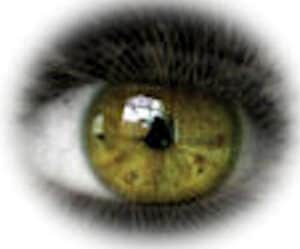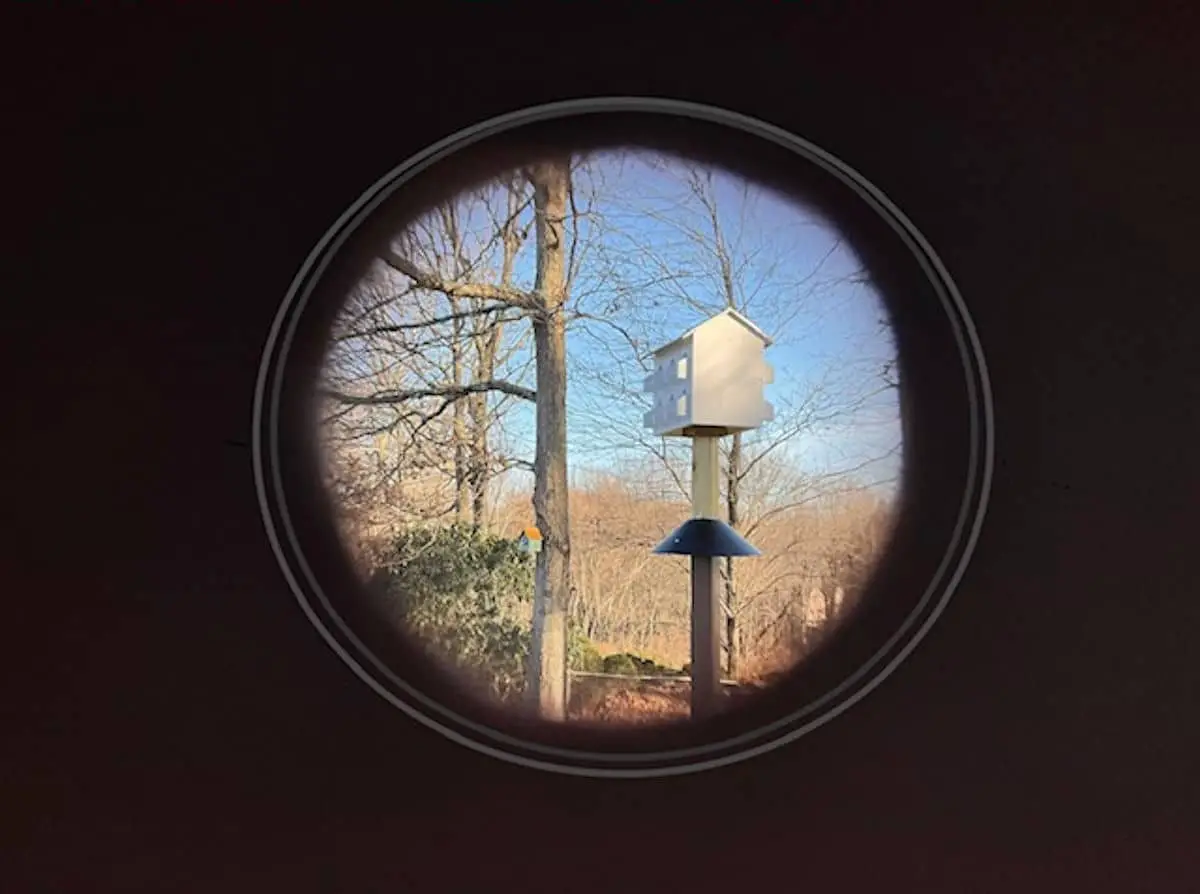Telescopes and binoculars are multi-lens devices that are used by the visually impaired, offering enhanced viewing capabilities for distance. These devices can also be tailored or modified to assist with closer viewing needs at intermediate and near distances.
While many of us are acquainted with the typical celestial telescopes and bird-watching binoculars, the systems designed for individuals with low vision are compact and specialized versions.
This article delves into the world of optical aids tailored for telescopic vision. These multi-lens systems serve as fundamental options for those requiring magnification for long distances. They effectively enlarge and bring distant objects into closer view.
The optical aids discussed here are different from the high-tech head-borne devices which use digital magnification. These high-tech devices are discussed in a separate article: Comparison of 14 Head-Borne Digital Magnifiers for Low Vision.
Factors that Affect Selection of the Telescope Magnification
- Size and weight,
- field of view, and
- light transmission.
An important factor to keep in mind with telescopes and binoculars is that stronger is not always better.
The stronger the lens system, the longer, heavier, and more cumbersome the telescope becomes.
Another factor is the field of view. The field of view is the amount of area you can see through the system. The more powerful the magnification, the smaller the field of view.
Also, the thicker, stronger lenses will transmit less light to the eye, which makes the distant details dimmer. This can be difficult for those with decreased contrast sensitivity.
If a telescopic lens system is prepared for you by a specialist, that person will match your vision requirements with the minimum power needed that will give you the largest field of view.
Types of Telescopes Available for those with Low Vision
Hand-held Telescopes
Spectacle Clip-on
Head-borne Spectacle Mounted, (monocular or binocular), Bioptic mounted spectacle, (monocular or binocular.)
Hand-held Telescopes for Low Vision
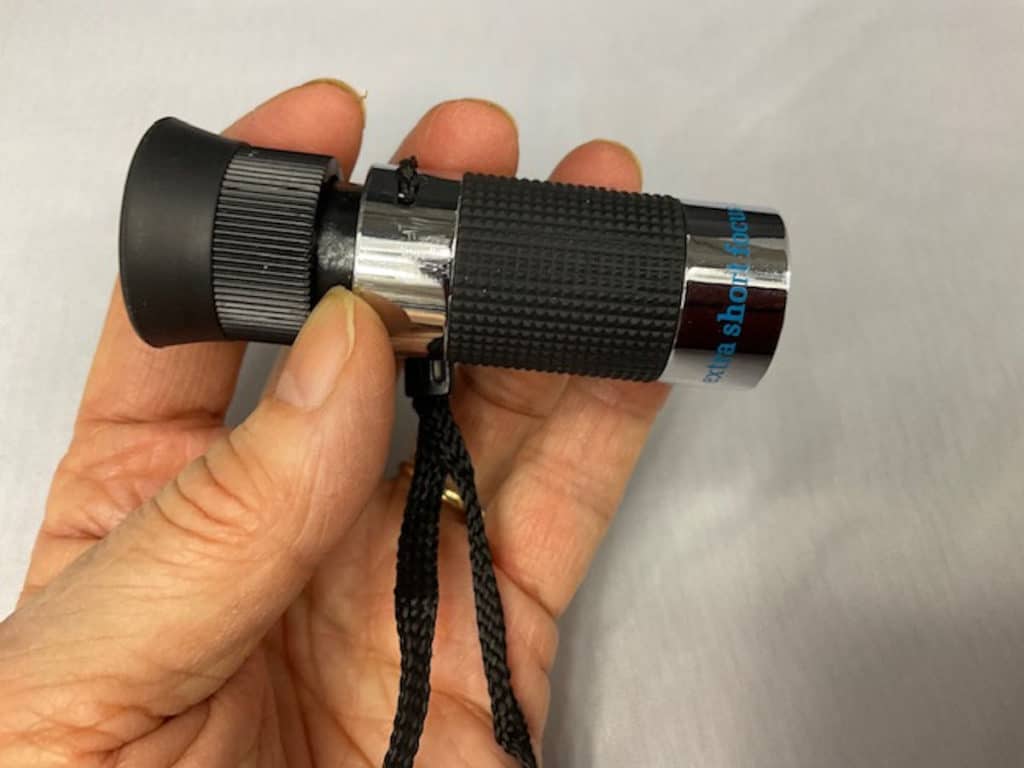
This optical aid is used over one eye.
Telescopes are generally not used when walking around. Not only because of their small field of view and the loss of side vision but there is motion parallax, meaning, a small movement of the head results in a seemingly large sweeping movement of objects seen through the telescope. These visual aids are primarily used in a stationary position for spotting or scanning. There are several types:
Hand-held telescopes are very portable and inexpensive. These units are used intermittently for spotting distant objects and are often marketed to sportsman.
Miniature telescopes vary in length from 2″ to 6″ (5 to 15 cm.) They will usually have a finger clip, wrist strap, or neck strap for intermittent usage.
Clip-on style telescopes


Clip-on telescope front and back
These are similar to the hand-held telescope with the addition of a clamp attached to it. The clamp is secured over the lens and frame of the user’s prescription eyewear. While this seems like a good idea, it adds weight and ‘unbalances’ the eyeglasses because it is mounted over one lens. It does make the telescope ‘hands-free’ for those with tremors. These are best used in a stationary position.
Binoculars as Low Vision Aids
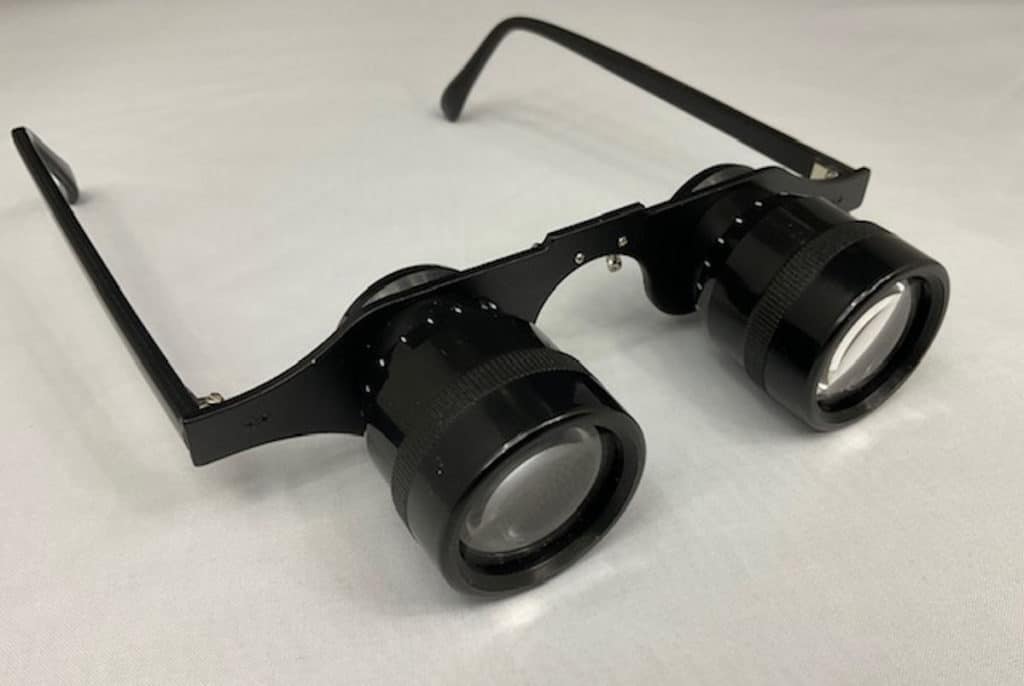
Binoculars can be hand-held or made as a set of head-mounted spectacles. Both of which should be focus-able. The head-mounted style can be found as a relatively inexpensive option, that you can adjust the fit and alignment yourself. They tend to be heavy and awkward looking.
There are also custom-made head-borne binoculars in which the lenses are mounted through the lenses of a standard-looking set of frames and your prescription lenses.
Considerably more expensive but well worth it if needed for long-term viewing. It is best used in a sitting position for viewing sporting events, theater, and watching television. They are more custom and need to be prescribed, measured, and aligned by a qualified professional.
What are Bioptic Telescopes? Distance Vision for Mobility
Bioptic is a term used to describe where the telescope is mounted on the eyeglass lens.
Whereas the previously described telescopes and binoculars were centrally located, these bioptics are located above the line of sight. Because the placement of the lens system is above the line of sight, a person can walk around with this spectacle-mounted device. When needed, the user drops their chin slightly and because the telescope was mounted with a slight 10° upward turn, the lens (or lenses) is now positioned straight ahead in front of the eye to spot distant targets.
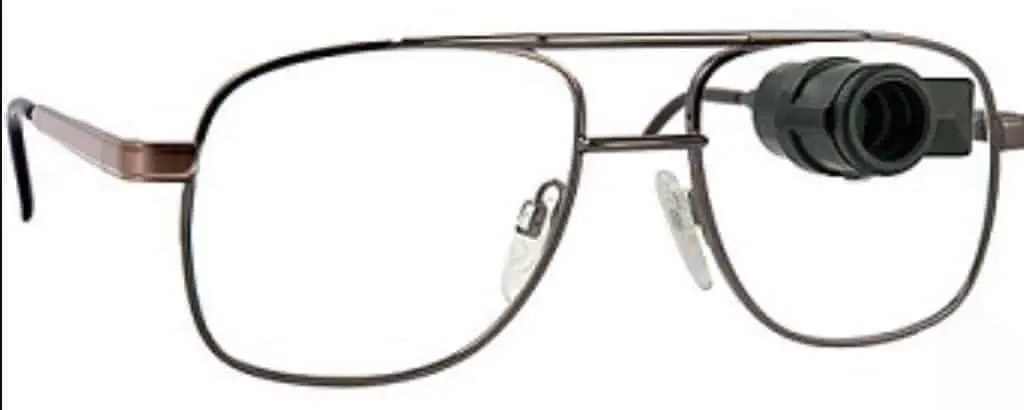
Bioptics are the type of telescopic system used by those who qualify as low vision drivers. The bioptic for driving is a single telescopic system mounted over one eye utilizing the person’s distant eyeglass prescription. The biopitic telescope is used intermittently by the driver to spot distant signs and traffic patterns.
There is a clip-on style bioptic telescope, designed by Ocutech, which is mounted on the nose bridge of the prescription eyewear and does not resemble a standard clip-on telescope. It is a monocular lens that has the appearance of a horizontal bar mounted at the top of the eyeglasses. It is lightweight and less obtrusive than a comparably powered clip-on telescope.
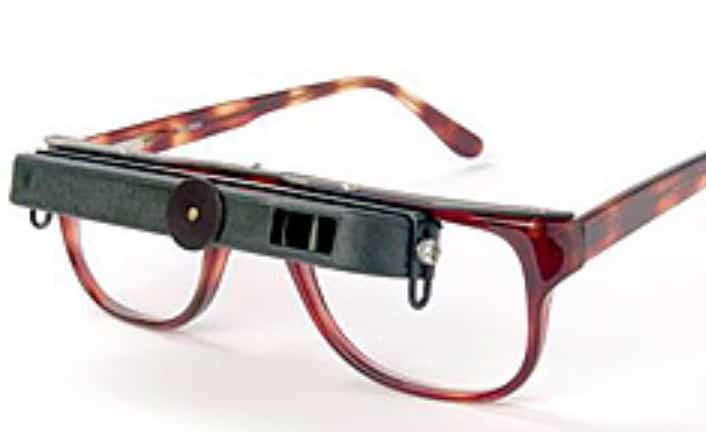
Within these categories, some are focus-able and some are fixed focus.
Viewing for Intermediate and Near
Other Features of the Miniature Telescopes
Fixed focus means that the distance is not adjustable. What you see is what you get.
Focusable offers more flexibility. While some are limited to focusing at different far distances, others can focus at the intermediate, which is within 10 feet to 28 inches (3 m to 71 cm) or as close as 6 inches (15 cm) for near.
Telemicroscopes are multi-lens systems used for intermediate and near reading distances. They can be telescopes (monocular) or binoculars. They can be the previously mentioned focus-able type, or they can be in the form of a reading cap, which is placed over the end of the telescope to turn a distance viewing system into one which can be used for reading at near.
Low Vision Glasses: Telemicroscopes

The benefit of this near reading option (reading cap or focusable) versus high-powered reading glasses (thick lenses ‘coke-bottle’ glasses) is the capability to hold the reading material at a further distance rather than the very close reading distance required by high-powered reading glasses.
The disadvantage is the smaller field of view.
Selecting an Optical Telescope System.
The first objective is to determine how the visual aid will be used:
The distance needed: far, intermediate, or near reading distance.
Term of use: occasional spotting or long-term viewing (examples, reading or watching television.)
Place to be used: stationary or mobile.
The choice of how much magnification is probably the most difficult to determine. The choice is a balancing act between:
– the individual’s visual acuity,
– now much magnification is needed for the activity, and
– the acceptable field of view.
The lowest amount of magnification is usually 1.7X. (that is 1.7 times larger image size.) The field of view will be about 28°.
2.2X is most commonly prescribed for those with 20/60 to 20/80 vision. It is possible to have a field of view of 12° to 16°.
3X is a better choice for those with the visual acuity of 20/100 to 20/200. Depending on the lens system, the field of view will be about 10° to 14° (expanded field.)
4X is better for those with 20/200 to 20/400 visual acuity. In this power, the best field of view will be between 6° to 9°(expanded field.)
These are all approximations and vary by the style of the telescope system (named as Galilean or keplarian). If a lens system is described as ‘expanded field’, you can expect it will be a little longer in length and heavier.
Want to understand more about macular degeneration? Read: The 7 Truths about AMD
In the End…
Telescopic lens systems are optical low vision aids. They vary by:
Binocular or monocular,
mounted centrally or in the bioptic position,
focusable or non-focusable (fixed; distance only or near only),
hand-held or spectacle mounted, and
spectacle mounted can be through-the-lens or clamped on.
Low vision telescopes can be purchased relatively inexpensively. Telescopes that are prescribed and fitted by a professional are pricier, but the functionality, comfort, and vision will be optimal.
